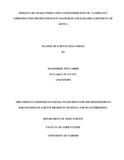| dc.description.abstract | The current decline in citrus production in the country is attributed to a great extent to Huanglongbing
(HLB) (greening) disease, caused by a phloem limited Liberobacter species belonging to the alpha
sub-division of the class Proteobacteria. A study was undertaken to characterize bacteria, which
cause the HLB disease in citrus plants in Machakos and Kakamega districts lower highlands (LH,
1800-1900mASL); upper midlands (UM, 1390-1475mASL), lower midlands (LM, 1000-1390m) and
to determine the distribution of the HLB disease across agroecological zones (AEZs) and varieties in
the two districts. In the surveys farms and citrus trees were randomly sampled, scored and bacterial
DNA isolated from the leaf samples. PCR was done to amplify specific ribosomal regions on the
bacterial genome and these regions were sequenced and systematically analysed for homology.
There were significant (P<0.05) differences in the distribution of the HLB disease among the four
citrus varieties in Machakos district. The washington navel oranges had the highest incidence with a
mean visual score (MVS) of 2.62 and a mean PCR score (MPS) of 0.81. There were significant
(P<0.05) differences in the distribution of HLB disease among the agro-ecological zones of
Machakos district. The UM4 AEZ had the highest incidence (MVS of 2.33, MPS of 0.67). In
Kakamega the MVS showed significant (P<0.05) differences while the MPS did not in the
distribution of the HLB disease among citrus varieties. The distribution of HLB disease among the
agro-ecological zones of Kakamega district was significant (P<0.05) based on the MVS and not
significant (P<0.05) based on MPS. MPS and the MVS were highly correlated in Machakos and
Kakamega (r2 of 0.703 and 0.661 respectively). The distribution of the psyllid (Trioza erytreae)
across AEZs and citrus varieties showed significant (P<0.05) differences in Machakos district and the
differences were insignificant (P<0.05) in Kakamega district. LH4 had the highest psyllid infestation
with a score of 0.833 while LM5 had the least psyllid infestation score (0.167).
xii
The PCR reactions with 16SrDNA, 16S/23SrDNA and L10/L12 ribosomal protein rDNA primers
produced 1100bp, 800bp and 716-720bp DNA fragments respectively from diseased plants. The
L10/L12 ribosomal protein rDNA consisted of; 536 bp L10 protein DNA; 44 bp of DNA intergenic
region and 136 basepairs of DNA that partially encodes the L12 protein. Sequences of rpL10/L12
protein genes from Kenyan strains were 99% and 83% similar to the South African “Candidatus L.
africanus Nelspruit” and the Asian “Candidatus L. asiaticus” strains, respectively. The intergenic
rDNA sequence of Kenyan strain from UM and LM showed 84% similarity with “Candidatus L.
africanus Nelspruit” and 50% similarity with “Candidatus L. asiaticus” strain. However, the LH
strain from Kakamega had an 11- basepairs deletion, while the LM4 from Machakos had a 5-basepair
deletion in the intergenic region compared to all other strains.
The strains of HLB bacteria in Machakos are different from those in Kakamega. They are close
descendants of South African strains, suggesting the origin of the disease. PCR primers can be
developed from the unique intergenic regions for early indexing for different strains of the bacteria.
This technique can be adopted by the Kenya Plant Health Inspectorate Service to curb the cross
border movement of the HLB diseased citrus. In addition, the tolerance exhibited by the rough lemon
can be harnessed and introduced to high yielding citrus varieties. Finally, control of the HLB disease
and the psyllid vector should be emphasized in agroecological zones that lie above 1400mASL. | en |

